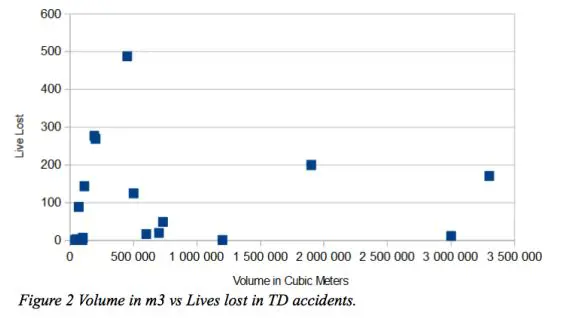Experience shows that successful risk communication always focuses on planned control measures and precautionary actions rather than on risks. Indeed, like in many other fields, actions speak louder than words. Actions are what matter to the public. Thus, today, we explore our experience in tailings dam risk communication.
In mining, oil and gas and other industries, people want to know what preventative actions are foreseen, even if the likelihood of an accident and associated risk is very low. Indeed, very low likelihood events actually do occur (Fukushima and other nuclear accidents, hazmat industry, etc.). For tailings dams breaks, at a rate of 1−4 catastrophic tailings releases per year, concerns are warranted despite the low risk.
The considerations above may explain why the public
- puts more emphasis on what is done to reduce accidents, rather than on the details of the accidents and their potential effects
- cares about the skills and awareness of the operations manager more than about the risk itself
- perceives mismanagement, incompetence, and lack of conscientiousness as the central issues in accidents
Furthermore, academic and popular literature suggest that the public’s distrust of industry has increased over the past 50 years. That distrust likely grew as a result of repeated failures to provide adequate and/or accurate risk information to the public and, in some cases, blatant or perceived conflict of interest.
Tailings Dam Risk Communication
Undoubtedly, the media and some authors push for sensationalism, oftentimes unsupported by facts. The sensationalism is oftentimes the result of pre-existing beliefs or biased interpretation of incomplete databases. This is not a recommendable path when communicating risks. Our experience shows that modern dams, especially the largest ones, have better investigations, design, construction, management and monitoring than any older structure we know. Thus, based on our experience, we see their probability of failure decrease to similar to those of hydraulic structures of the same caliber.
We have put together a selection of tailings dam failures in the last 45 years. They occurred at medium-height dams in base and precious metals mining operations. They are, from the oldest to the most recent:
- Bafokeng, South Africa, 1974
- Merriespruit, South Africa, 1994
- Los Frailes, Spain, 1998
- Baia Mare, Romania, 2000
- Mount Polley, Canada, 2014
- Samarco, Brazil, 2015
- Córrego do Feijão, Brazil, 2019
In this sample, Samarco is an exception with its 100 m height, with peculiarities highlighted by forensic studies, design changes and extremely high average raise per annum. Córrego do Feijão had the longest life to failure of the group (87 years), and Samarco and Baia Mare had the shortest.
At this date, we have no information on the years to failure for Baia Mare and Merriespruit, nor on the raise history of Bafokeng, Merriespruit, Los Frailes and Baia Mare. We also have serious doubts on the values we have found for the average raise (m/yr) of Baia Mare and Samarco. We encourage anyone with information to share their information with us to inform our risk assessment methodology.
Ultimately, all the structures above had aspects of investigations, design, construction and operations and management, leading them far astray from what would be considered an excellent large dam today.
Contrary to Popular Belief
The statement that larger structures failures lead to larger consequences than those of smaller structures has been proven wrong in many cases. For example, the 1985 Val de Stava failure in Italy had a relatively small 300,000m3 release with extremely serious consequences.
Indeed, many parameters drive consequences, above and beyond the size of the dam. The interplay of probability and consequences does not necessarily mean risks of smaller or larger dams are more or less tolerable. In addition, we unambiguously showed in a graph in our 2015 paper “Tailings Facility Failures in 2014 and an Update on Failure Statistics” that the volume released in a failure does not correlate to lives lost (see figure below).

